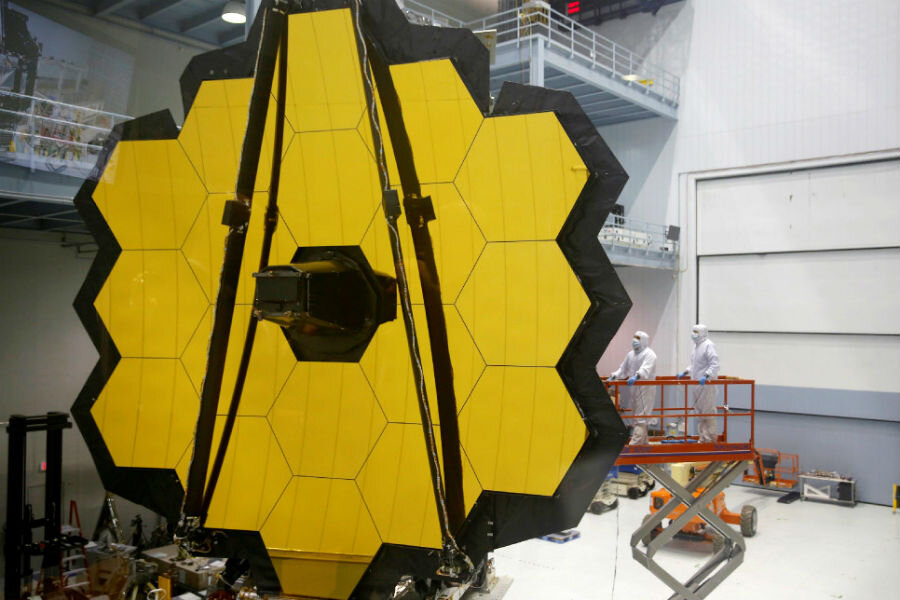Bass-note bumps: NASA to resume vibration tests on James Webb telescope
Loading...
NASA officials announced Tuesday that the James Webb Space Telescope, the highly anticipated successor to the Hubble Space Telescope, is set to resume testing later this month.
Pre-launch testing had been halted on the device after unexpected readings were detected during an analysis designed to ensure that the telescope would survive takeoff. Scientists say that they are close to determining the cause of the problem.
Detecting and fixing flaws in orbital scientific equipment is nothing new for NASA engineers, but there is a lot on the line for the James Webb observatory, set to be the most powerful telescope ever created after it goes into orbit in 2018. For the scientists working on the project, the device represents a new pinnacle in scientific achievement, with the potential to outshine even the famed Hubble Space Telescope, which has been turning in significant discoveries since it was launched in 1990.
In December 2016, scientists at Goddard Space Flight Center were running shock and vibrational tests on the James Webb telescope in order to determine whether there was any threat of damage to the telescope during the heavy vibrations that inevitably occur during launch. Vibration testing is a common technique employed by NASA that, among other things, identifies specific frequencies that cause unexpected resonances in the equipment, which, if damaged during the launch, could be difficult to fix. During one test on Dec. 3, a specific frequency, roughly equating to a note below the bottom note of a standard piano (a very low A flat), caused accelerometers attached to the telescope to have unexpected readings, which prompted an automatic shutdown of the test.
"The Webb telescope is the most dynamically complex test article ever tested at Goddard, so the responses were a bit different than expected," Paul Geithner, a deputy project manager for the Webb telescope at NASA's Goddard Space Flight Center, said in a NASA statement.
Since the Dec. 3 test, the team has conducted various visual and ultrasonic examinations in order to determine whether the telescope is sound. Now they say they are narrowing in on the cause of the problem, and aim to resume vibration and shock tests before the end of January. The tests will measure the resonances of the telescope as a whole, as well as the resonances of specific components, in order to make sure that the $8.8 billion telescope makes the trip into orbit intact.
"This is why we test – to know how things really are, as opposed to how we think they are," Geithner said in the statement.
Despite various design obstacles, cost overruns, and multiple delays over the past few years of development, astronomers anticipate that the James Webb telescope will provide new insights – a step up from its aging predecessor, the Hubble telescope – once it actually reaches orbit. As The Christian Science Monitor's Lonnie Shekhtman previously reported:
Though the tools aboard both observatories are meant to study the same phenomena – star births and the evolution of galaxies Webb will be able to see much farther into the history of our universe, back to the first generation of stars and galaxies that formed after the Big Bang 13.8 billion years ago.
It will have a much larger main mirror than Hubble's (6.5 meters in diameter, 2.7 times bigger), boosting its power to collect light. It will also be equipped with a more powerful detector than Hubble's, one that can observe very faint infrared light left in the wake of distant galaxies that are speeding away in all directions of the universe. The James Webb telescope will also include spectroscopy and photometry instruments that will measure the intensity of electromagnetic radiation emanating from celestial bodies.
A five-layer sunshield the size of a tennis court will protect Webb’s mirrors and instruments from the sun, Earth, moon, and its own electronics.
The James Webb telescope also boasts the impressive engineering feat of being able to fold itself up like origami during launch, before unfurling over the course of two weeks once it arrives in orbit. Once the orbital observatory is fully deployed, it is expected to operate for at least a decade.








